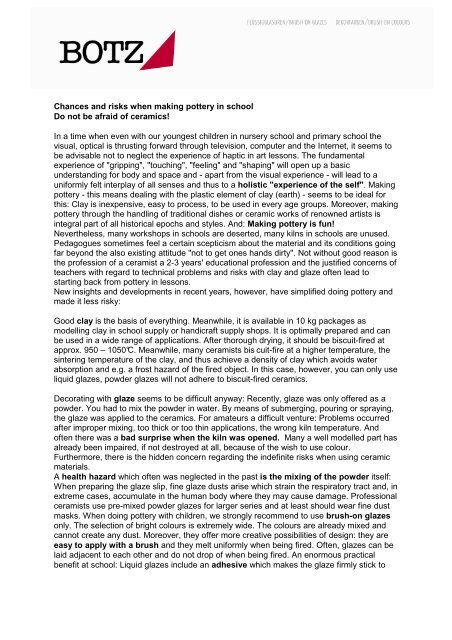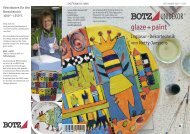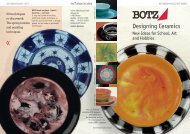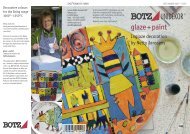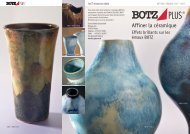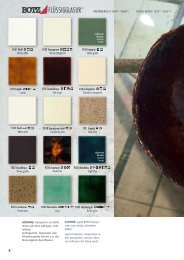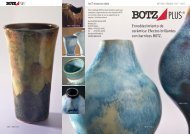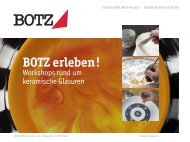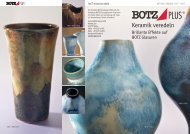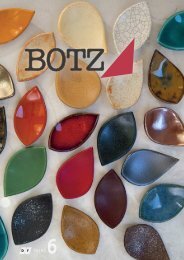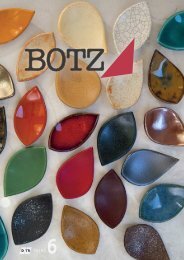Chances and risks when making pottery in school - BOTZ Glasuren
Chances and risks when making pottery in school - BOTZ Glasuren
Chances and risks when making pottery in school - BOTZ Glasuren
You also want an ePaper? Increase the reach of your titles
YUMPU automatically turns print PDFs into web optimized ePapers that Google loves.
<strong>Chances</strong> <strong>and</strong> <strong>risks</strong> <strong>when</strong> <strong>mak<strong>in</strong>g</strong> <strong>pottery</strong> <strong>in</strong> <strong>school</strong><br />
Do not be afraid of ceramics!<br />
In a time <strong>when</strong> even with our youngest children <strong>in</strong> nursery <strong>school</strong> <strong>and</strong> primary <strong>school</strong> the<br />
visual, optical is thrust<strong>in</strong>g forward through television, computer <strong>and</strong> the Internet, it seems to<br />
be advisable not to neglect the experience of haptic <strong>in</strong> art lessons. The fundamental<br />
experience of "gripp<strong>in</strong>g", "touch<strong>in</strong>g", "feel<strong>in</strong>g" <strong>and</strong> "shap<strong>in</strong>g" will open up a basic<br />
underst<strong>and</strong><strong>in</strong>g for body <strong>and</strong> space <strong>and</strong> - apart from the visual experience - will lead to a<br />
uniformly felt <strong>in</strong>terplay of all senses <strong>and</strong> thus to a holistic "experience of the self". Mak<strong>in</strong>g<br />
<strong>pottery</strong> - this means deal<strong>in</strong>g with the plastic element of clay (earth) - seems to be ideal for<br />
this: Clay is <strong>in</strong>expensive, easy to process, to be used <strong>in</strong> every age groups. Moreover, <strong>mak<strong>in</strong>g</strong><br />
<strong>pottery</strong> through the h<strong>and</strong>l<strong>in</strong>g of traditional dishes or ceramic works of renowned artists is<br />
<strong>in</strong>tegral part of all historical epochs <strong>and</strong> styles. And: Mak<strong>in</strong>g <strong>pottery</strong> is fun!<br />
Nevertheless, many workshops <strong>in</strong> <strong>school</strong>s are deserted, many kilns <strong>in</strong> <strong>school</strong>s are unused.<br />
Pedagogues sometimes feel a certa<strong>in</strong> scepticism about the material <strong>and</strong> its conditions go<strong>in</strong>g<br />
far beyond the also exist<strong>in</strong>g attitude "not to get ones h<strong>and</strong>s dirty". Not without good reason is<br />
the profession of a ceramist a 2-3 years' educational profession <strong>and</strong> the justified concerns of<br />
teachers with regard to technical problems <strong>and</strong> <strong>risks</strong> with clay <strong>and</strong> glaze often lead to<br />
start<strong>in</strong>g back from <strong>pottery</strong> <strong>in</strong> lessons.<br />
New <strong>in</strong>sights <strong>and</strong> developments <strong>in</strong> recent years, however, have simplified do<strong>in</strong>g <strong>pottery</strong> <strong>and</strong><br />
made it less risky:<br />
Good clay is the basis of everyth<strong>in</strong>g. Meanwhile, it is available <strong>in</strong> 10 kg packages as<br />
modell<strong>in</strong>g clay <strong>in</strong> <strong>school</strong> supply or h<strong>and</strong>icraft supply shops. It is optimally prepared <strong>and</strong> can<br />
be used <strong>in</strong> a wide range of applications. After thorough dry<strong>in</strong>g, it should be biscuit-fired at<br />
approx. 950 – 1050°C. Meanwhile, many ceramists bis cuit-fire at a higher temperature, the<br />
s<strong>in</strong>ter<strong>in</strong>g temperature of the clay, <strong>and</strong> thus achieve a density of clay which avoids water<br />
absorption <strong>and</strong> e.g. a frost hazard of the fired object. In this case, however, you can only use<br />
liquid glazes, powder glazes will not adhere to biscuit-fired ceramics.<br />
Decorat<strong>in</strong>g with glaze seems to be difficult anyway: Recently, glaze was only offered as a<br />
powder. You had to mix the powder <strong>in</strong> water. By means of submerg<strong>in</strong>g, pour<strong>in</strong>g or spray<strong>in</strong>g,<br />
the glaze was applied to the ceramics. For amateurs a difficult venture: Problems occurred<br />
after improper mix<strong>in</strong>g, too thick or too th<strong>in</strong> applications, the wrong kiln temperature. And<br />
often there was a bad surprise <strong>when</strong> the kiln was opened. Many a well modelled part has<br />
already been impaired, if not destroyed at all, because of the wish to use colour.<br />
Furthermore, there is the hidden concern regard<strong>in</strong>g the <strong>in</strong>def<strong>in</strong>ite <strong>risks</strong> <strong>when</strong> us<strong>in</strong>g ceramic<br />
materials.<br />
A health hazard which often was neglected <strong>in</strong> the past is the mix<strong>in</strong>g of the powder itself:<br />
When prepar<strong>in</strong>g the glaze slip, f<strong>in</strong>e glaze dusts arise which stra<strong>in</strong> the respiratory tract <strong>and</strong>, <strong>in</strong><br />
extreme cases, accumulate <strong>in</strong> the human body where they may cause damage. Professional<br />
ceramists use pre-mixed powder glazes for larger series <strong>and</strong> at least should wear f<strong>in</strong>e dust<br />
masks. When do<strong>in</strong>g <strong>pottery</strong> with children, we strongly recommend to use brush-on glazes<br />
only. The selection of bright colours is extremely wide. The colours are already mixed <strong>and</strong><br />
cannot create any dust. Moreover, they offer more creative possibilities of design: they are<br />
easy to apply with a brush <strong>and</strong> they melt uniformly <strong>when</strong> be<strong>in</strong>g fired. Often, glazes can be<br />
laid adjacent to each other <strong>and</strong> do not drop of <strong>when</strong> be<strong>in</strong>g fired. An enormous practical<br />
benefit at <strong>school</strong>: Liquid glazes <strong>in</strong>clude an adhesive which makes the glaze firmly stick to
the body after dry<strong>in</strong>g. This is why pupils can easily carry out the transport to the burn<strong>in</strong>g kiln.<br />
Portions of float<strong>in</strong>g agents <strong>in</strong> the bond of the liquid glaze chemically prevent the glaze<br />
from settl<strong>in</strong>g after a short time <strong>and</strong> becom<strong>in</strong>g hard. The somewhat higher price of liquid<br />
glazes is relativised by an optimal utilisation <strong>and</strong> a high productiveness: 800 ml liquid glaze,<br />
for example, correspond with approx. 1.4 kg powder glaze. Detailed tips on use <strong>and</strong> design<br />
are to be found <strong>in</strong> well made brochures or the Internet.<br />
It is very effective <strong>and</strong> popular to let relief structures <strong>in</strong> the clay to the fore by means of<br />
brownstone without teachers know<strong>in</strong>g the health hazard com<strong>in</strong>g along with brownstone.<br />
Brownstone is an impure manganese <strong>and</strong> as such it is to be labelled as "hazardous to health<br />
after <strong>in</strong>hal<strong>in</strong>g <strong>and</strong> swallow<strong>in</strong>g" <strong>and</strong> should not be used <strong>in</strong> <strong>school</strong>s. As an alternative, nontoxic<br />
liquid decorative colours can be used here which are pa<strong>in</strong>ted over the relief <strong>and</strong><br />
superficially wiped off aga<strong>in</strong> after the beg<strong>in</strong>n<strong>in</strong>g of dry<strong>in</strong>g.<br />
A very great hazard is lead. Because of its low melt<strong>in</strong>g po<strong>in</strong>t, it is often an <strong>in</strong>gredient of many<br />
powder glazes <strong>in</strong> order to achieve certa<strong>in</strong> effects at low temperatures. Even after fir<strong>in</strong>g,<br />
ceramics that come <strong>in</strong>to contact with light acids may release lead which may be hazardous<br />
to health. Lead must <strong>and</strong> should no longer be used <strong>in</strong> <strong>school</strong> <strong>and</strong> leisure activities <strong>and</strong> many<br />
glaze manufacturers offer wonderful, impressive alternatives without any lead. Yet other<br />
raw materials which are added to glazes for reasons of effects should be done without.<br />
Meanwhile, the tightrope walk between desired colourfulness <strong>and</strong> to be avoided health<br />
hazards has been facilitated for health-conscious consumers: they can orient themselves at<br />
the term "non-toxic". This term means that the products do not <strong>in</strong>clude any hazardous<br />
materials <strong>in</strong> concentrations which would have to be labelled.<br />
In general, the follow<strong>in</strong>g applies to work<strong>in</strong>g with clay <strong>and</strong> glaze:<br />
- do not eat, dr<strong>in</strong>k <strong>and</strong> smoke dur<strong>in</strong>g glaz<strong>in</strong>g<br />
- thoroughly wash your h<strong>and</strong>s after glaz<strong>in</strong>g<br />
- do not work <strong>in</strong> the fir<strong>in</strong>g room dur<strong>in</strong>g fir<strong>in</strong>g, always pay attention to a good exhaust of<br />
gases <strong>and</strong> to a complete ventilation of the fir<strong>in</strong>g room<br />
Fir<strong>in</strong>g often is made by caretakers s<strong>in</strong>ce many h<strong>and</strong>icraft teachers consider adjust<strong>in</strong>g the<br />
burn<strong>in</strong>g process to be complicated. In fact, it is mere child's play today to operate an<br />
electronic control system s<strong>in</strong>ce firm fir<strong>in</strong>g sequences mostly are stored <strong>and</strong> only have to be<br />
called. You may contact the kiln manufacturer any time who will provide you with exact<br />
operat<strong>in</strong>g <strong>in</strong>structions, if required.<br />
It is fun to fire someth<strong>in</strong>g yourself <strong>and</strong> possibly to vary with temperatures. Apart from usual<br />
glaze burn<strong>in</strong>g at 1040 – 1080°C (stoneware) it is ex cit<strong>in</strong>g for more tra<strong>in</strong>ed friends of<br />
ceramics to fire at very high temperatures of approx. 1220 – 1260°C <strong>and</strong> to produce<br />
particularly resistant crockery for everyday use <strong>in</strong> this way.<br />
The potential of clay with regard to art education is manifold, the sensual act of plastic<br />
form<strong>in</strong>g is fundamental. The process of fir<strong>in</strong>g permits <strong>in</strong>sights <strong>in</strong>to chemical processes<br />
show<strong>in</strong>g how greyish pastes result <strong>in</strong> colour-<strong>in</strong>tensive glasses. Mak<strong>in</strong>g Pottery is <strong>and</strong> will<br />
rema<strong>in</strong> excit<strong>in</strong>g!<br />
With the new materials, traditional h<strong>and</strong>icraft will get new impulses, do<strong>in</strong>g <strong>pottery</strong> <strong>in</strong> <strong>school</strong> is<br />
mere child's play <strong>and</strong> thus is fun for teachers <strong>and</strong> pupils. And, open<strong>in</strong>g the fir<strong>in</strong>g kiln will<br />
rema<strong>in</strong> to be connected with surprises, however, rather with positive ones …<br />
Mechthild Surmann


